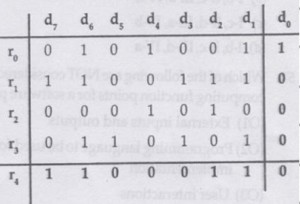CN Data Link Layer
Question 41
Data transmitted on a link uses the following 2D parity scheme for error detection:
Each sequence of 28 bits is arranged in a 4×7 matrix (rows r0 through r3, and columns d7 through d1) and is padded with a column d0 and row r4 of parity bits computed using the Even parity scheme. Each bit of column d0 (respectively, row r4) gives the parity of the corresponding row (respectively, column). These 40 bits are transmitted over the data link.

The table shows data received by a receiver and has n corrupted bits. What is the minimum possible value of n?

The table shows data received by a receiver and has n corrupted bits. What is the minimum possible value of n?
Question 42
Suppose that the one-way propagation delay for a 100 Mbps Ethernet having 48-bit jamming signal is 1.04 micro-seconds. The minimum frame size in bits is:
Question 43
Which of the following statement is False about the efficiency of the given channel?
Question 44
Consider a simple communication system where multiple nodes are connected by a shared broadcast medium (like Ethernet or wireless). The nodes in the system use the following carrier-sense the medium access protocol. A node that receives a packet to transmit will carrier-sense the medium for 5 units of time. If the node does not detect any other transmission in this duration, it starts transmitting its packet in the next time unit. If the node detects another transmission, it waits until this other transmission finishes, and then begins to carrier-sense for 5 time units again. Once they start to transmit, nodes do not perform any collision detection and continue transmission even if a collision occurs. All transmissions last for 20 units of time. Assume that the transmission signal travels at the speed of 10 meters per unit time in the medium.
Assume that the system has two nodes P and Q, located at a distance d meters from each other. P starts transmitting a packet at time t = 0 after successfully completing its carrier-sense phase. Node Q has a packet to transmit at time t = 0 and begins to carrier-sense the medium.
The maximum distance d (in meters, rounded to the closest integer) that allows Q to successfully avoid a collision between its proposed transmission and P’s on going transmission is _______ .
Note -This was Numerical Type question.
Question 45
Which of the following devices takes data sent from one network device and forwards it to the destination node based on MAC address ?
Question 47
Suppose we want to download text documents at the rate of 100 pages per second. Assume that a page consists of an average of 24 lines with 80 characters in each line. What is the required bit rate of the channel?
Question 48
If a file consisting of 50,000 characters takes 40 seconds to send, then the data rate is __________.
Question 50
The maximum size of the data that the application layer can pass on to the TCP layer below is __________.
(A) 216 bytes
(B) 216 bytes + TCP header length
(C) 216 bytes - TCP header length
(D) 215 byte.
There are 117 questions to complete.
Last Updated :
Take a part in the ongoing discussion
